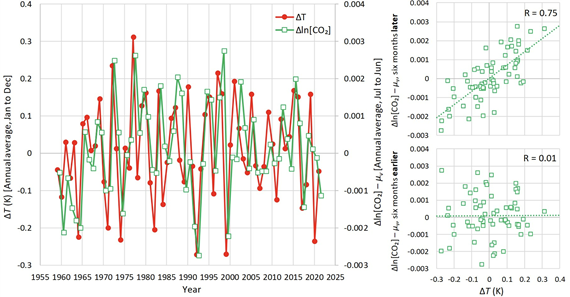
The original version of this blog – written by Giacomo Grassi, with contributions from Stefano Caserini, Giorgio Vacchiano, Gianni Comoretto, Claudio della Volpe, and Mario Grosso - appeared in the Italian climate website Climalteranti. The version here has been checked and further enriched by Pierre Friedlingstein (Global Carbon Project).
A recent article suggests that the accumulation of CO2 in the atmosphere is caused by the influence of temperature on natural systems, rather than fossil fuels. But it's a glaring mistake, like confusing the brake with the accelerator.
A few months ago, a scientific article titled "On Hens, Eggs, Temperatures and CO2: Causal Links in Earth’s Atmosphere" was released, led by Demetris Koutsoyiannis, a professor of Hydrology at the University of Athens. The article analyzes the correlation between temperature difference (ΔT) and atmospheric CO2 concentration difference (ΔCO2) over the past 60 years. The correlation is evident between ΔT and ΔCO2 six months later, while it is null between ΔT and ΔCO2 six months earlier (figure 1 below). From these correlations, the authors conclude that it is not the variation in CO2 levels that influences temperatures, as claimed by a century of climate science and the IPCC, but the exact opposite.
Figure 1: From Koutsoyiannis et al. 2023
The authors further assert, among other things, that: (i) the sequence they propose (first an increase in temperature, then a raise in atmospheric CO2 concentration) is well-documented in the planet's geological history; (ii) currently, human activities contribute only 4% of total emissions, with natural emissions being dominant and their increase - due to rising temperatures - more than three times higher than those linked to human activities.
The study has received some attention in climate change-denying or skeptic circles (e.g. here).
Acknowledging that the observed correlation may raise doubts among non-experts, this post briefly outlines how the conclusions of the study by Koutsoyiannis et al. represent a glaring mistake.
Let's start with what scientists studying the carbon cycle, whose data is utilized in IPCC reports, have to say. According to the Global Carbon Project, which annually publishes the Global Carbon Budget, anthropogenic CO2 emissions have reached about 40 billion tons per year on average over the last decade. These emissions are predominantly from fossil fuels (88%) and partly from land use and deforestation (12%) (see figure below). Only about 45% of these emissions remain in the atmosphere. The remaining portion is absorbed by terrestrial ecosystems (around 30%) and oceans (around 25%).
Figure 2: Approximated numbers from Friedlingstein et al. 2023, Global Carbon Project
Over the past 60 years, emissions from fossil fuels have increased rapidly, with a slowdown in the last decade (see figure below), while emissions from deforestation have slightly decreased. Net CO2 uptake by oceans and terrestrial ecosystems has increased proportionally to emissions from human activities, leaving the fraction of these emissions remaining in the atmosphere (airborne fraction) relatively constant over time (about 45%). It's important to note the significant interannual variability in net CO2 uptake by terrestrial ecosystems, causing a corresponding strong variability in CO2 accumulation in the atmosphere.
Figure 3: Source Global Carbon Project
How certain are we of these estimates? Some things we know quite well, others less so. For example, the estimates of emissions from fossil fuels (uncertainty of 5%) and the accumulation of CO2 in the atmosphere (uncertainty of 2%) are highly precise. However, we are still somewhat uncertain about the net uptake of CO2 (uncertainty of 14% for oceans and 24% for terrestrial ecosystems), and especially about emissions from land use and deforestation (uncertainty of 54%).
Let's now revisit what was stated in Koutsoyiannis' study.
Is it true that in the planet's climatic history, temperature increases before atmospheric CO2 concentrations? In several cases, yes, as well-known to climatologists and explained here: changes in glacial cycles over the last 800,000 years were initiated by changes in Earth's orbit and then amplified by the temperature-CO2 feedback, mainly mediated by oceans (the warmer the ocean, the less CO2 it can dissolve, and vice versa). In other cases, however, the sequence was reversed, with volcanic CO2 causing temperature rises. However, it's crucial to note that the observation of a phenomenon in the past, and its potential ongoing occurrence, does not necessarily imply that this phenomenon predominantly explains what we observe today, particularly the increase in atmospheric CO2. Conclusions such as "climate has always changed due to natural causes, so today's changes are unrelated to human activity" represent a logical fallacy alien to the scientific method (see figure below).

Cranky Uncle cartoon from Skeptical science
Is it true that human CO2 emissions are 4% of natural ones? Yes, this is the order of magnitude, if one only considers the estimates of gross natural CO2 emissions. Gross natural emissions include plants respiration and soils carbon decomposition as well as outgassing of CO2 from the oceans. However, what Koutsoyiannis fails to mention is that these gross natural CO2 emissions are more than balanced by gross natural CO2 absorptions (see figure below), including terrestrial and marine photosynthesis and the uptake of CO2 by the oceans. What matters for the accumulation of CO2 in the atmosphere is the net flux, i.e., the difference between gross emissions and absorptions.
Source: Cranky Uncle vs. Climate Change by John Cook. Please note that this cartoon is illustrative in nature as an example for cherry picking and that the numbers shown are from 2023.
Let's explain it with an analogy: imagine a bathtub with a continuous flow of water entering and exiting (for example, 20 liters per minute). In the absence of human interference (emissions from fossil fuels), these flows (emissions and absorptions, or sinks) balance each other out, and the water level in the bathtub (CO2 in the atmosphere) remains constant. Now, imagine adding an additional inflow (human emissions), small compared to the natural one (1 liter per minute), which in turn stimulates a further small outflow (0.5 liters per minute of additional natural sinks). Although these two additional flows are modest compared to the original ones, over time they can significantly alter the natural balance: consequently, the water level in the bathtub increases, minute after minute. The same happens with emissions and the concentration of CO2 in the atmosphere, year after year.
Figure 4: Modified from Climate interactive.
Is it possible for Koutsoyiannis' claim to hold true, that the increase in natural emissions caused by rising temperatures - more than three times greater than human emissions - is the dominant factor explaining the increase in atmospheric CO2?
Verifying this is not difficult using well-known data on the carbon cycle. And here's where the problem lies. If Koutsoyiannis' thesis were true, it would follow that: (i) the increase in CO2 in the atmosphere would be at least three times higher than human emissions and (ii) natural processes would be a net source of CO2 emissions. It's easy to verify that both these consequences are not occurring at all: the increase in CO2 in the atmosphere is less than half that of human emissions, which means that natural processes can only be a net CO2 sink (not a net source as claimed by Koutsoyiannis). This sink is mostly because the additional CO2 in the atmosphere stimulates photosynthesis on land and dissolution of CO2 in the ocean surface waters.
Another important verification can be done by analyzing carbon isotopes: different sources of CO2 have their own unique isotopic fingerprints. CO2 from the fossil fuel burning doesn't have carbon 14 (14C), and CO2 from terrestrial plants has less carbon 13 (13C) than from the ocean. Since fossil fuels are derived from ancient plants, they also have less 13C isotopes. Using this information, scientists can figure out why trends in 14C and 13C occur. Isotope data from ice cores show a decrease in the 13C/12C ratio since the beginning of the industrial era, which clearly indicates that the excess CO2 comes from fossil carbon, not from biogenic sources, as illustrated in the figure below.
Figure 5: from Rubino et al. 2013
Further confirmation of the role of fossil fuels can be drawn from ocean acidification and the decreasing trends in O2 levels, as explained here.
In short, there's simply no doubt that Koutsoyiannis has made a glaring mistake
But then, how should we interpret the correlations between temperature increase and the subsequent increase in atmospheric CO2 concentration found in Koutsoyiannis study?
Simply put, the interannual anomalies of atmospheric CO2 are influenced by climatic variability, mediated for example by El Niño, the cyclical warming of the equatorial Pacific that impacts global climate, including the productivity of terrestrial ecosystems and the frequency of fires. This affects the net amount of CO2 absorbed by terrestrial ecosystems in a given year, and thus the amount of CO2 remaining in the atmosphere. Is this groundbreaking? Well, not really: over the last 30 years, numerous studies have explored the relationship between climate variability and the global carbon cycle (for example, here, here, here or here), and the IPCC first reported on this in its third assessment, more than 20 years ago (IPCC TAR WG1 chapter 3, figure 3.3, 2001, reproduced below). Every IPCC report published since (4th, 5th and 6th IPCC assessments) summarised our knowledge on interannual variability of the carbon cycle and reaffirmed the clear role of climate variability on the land carbon fluxes on interannual time scales.
Figure 6: From IPCC TAR, WG1, chapter 3
In summary:
On interannual time scales, variations in the atmospheric CO2 growth rate are driven by the climate variability. El Niño years have larger than average atmospheric CO2 growth rates, while the opposite occurs during la Niña years. The fact that on short interannual time scales climate anomalies drive the carbon cycle anomalies in the atmospheric CO2 growth rate does not imply that climate is responsible for the long-term CO2 increase.
Some of the observations above are included in this study, in response to previous works by Koutsoyiannis, where it is noted that the correlation between CO2 and temperature strongly depends on the timescale used. While it's known that atmospheric CO2 fluctuations over a couple of years are caused by temperature variations, in the medium term, it's CO2 that typically drives the correlation (as in the last few decades, due to fossil fuels), while in the long term, other factors may determine temperature variations (such as orbital changes for glaciations), with CO2 simply representing a positive feedback.
In conclusion, the data are very clear: it's the use of fossil fuels that has caused the increase in atmospheric CO2 in recent decades, reaching levels not seen in at least 800,000 years. Natural systems represent a net absorption of CO2: by slowing the increase of CO2 in the atmosphere, they cannot be the cause of it. The interannual variability of this net absorption is influenced by temperature, which consequently indirectly influences the interannual variability of CO2 accumulation in the atmosphere.
Imagine acting with your right foot on the accelerator (CO2 emissions from fossil fuels) and with your left foot on the brake (CO2 absorption by natural systems). The accelerator is constantly pressed while the pressure on the brake fluctuates. It's evident that the oscillation on the brake influences the speed (CO2 accumulation in the atmosphere), but it would be wrong to conclude that the left foot is the cause of the speed. Yet, this is what the study by Koutsoyiannis et al. does, confusing the brake with the accelerator.
Statistics is an essential tool in much of scientific work. Occasionally, it can be used to draw conclusions incompatible with the reality we know beyond any reasonable doubt. Being an expert in one discipline (such as statistics) does not authorize drawing important conclusions in areas where one lacks expertise. Breaking this simple rule can lead to scientifically embarrassing missteps.
Posted by Guest Author on Friday, 31 May, 2024
 |
The Skeptical Science website by Skeptical Science is licensed under a Creative Commons Attribution 3.0 Unported License. |